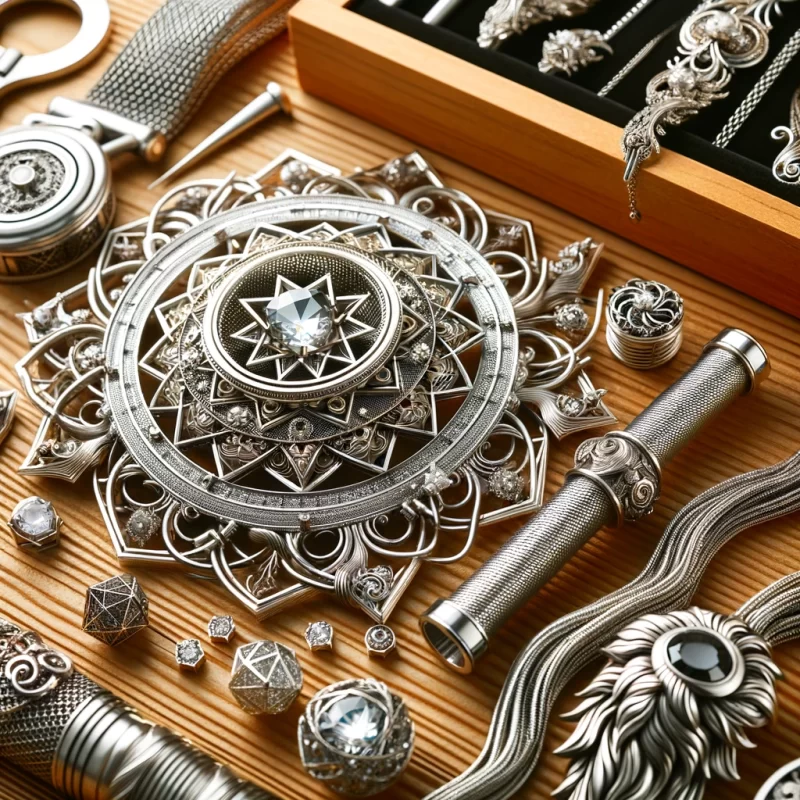
Table of Content
Ah, the world of jewelry! It’s vast, shimmering with an array of materials ranging from traditional golds and silvers to the more avant-garde-like carbon fiber. Yep, you heard that right—carbon fiber. This material, once the darling of the aerospace industry, has made a grand entrance into the realm of jewelry, bringing with it a breath of fresh, innovative air. Today, I’m going to give you a backstage pass into the fascinating world of carbon fiber jewelry making. Strap in; it’s going to be an intriguing ride.
Carbon fiber, with its sleek, futuristic look, not only catches the eye but also tells a story of technology meeting art. The process begins with a vision, a design that dares to push the boundaries of traditional jewelry making. The inspiration? It could be the sleek lines of a sports car, the intricate weave of fabric, or even the fluidity of the natural world. Whatever the muse, it sparks the creation of something truly unique.
Creating carbon fiber jewelry isn’t your run-of-the-mill craft. It starts with carbon fiber sheets or threads that are as deceptive in their delicate appearance as they are robust in their structure. These fibers are then set into molds or intertwined to create the base shape of the jewelry piece. The process is meticulous, requiring a steady hand and an eye for detail.
But it’s not just about shaping; it’s about transforming. Carbon fiber’s appeal lies in its ability to be both lightweight and incredibly durable. This duality makes it a perfect candidate for rings, bracelets, and even intricate earrings. The material’s versatility allows for a range of finishes, from glossy to matte, and can be dyed to introduce color into the design.
The next stage involves refining and finishing, where the piece is sanded, polished, and sometimes combined with other materials like metals or gemstones. This is where the piece truly comes to life, revealing its final form—a sleek, modern accessory ready to make a statement.
Behind every carbon fiber piece is a story of innovation. Designers and craftsmen experiment with 3D printing and other cutting-edge techniques to achieve geometries and designs once thought impossible. The collaboration between designer and material is a dance of creativity and precision, resulting in jewelry that’s not just worn but experienced.
Yet, for all its modernity, making carbon fiber jewelry also demands a return to the artisanal roots of jewelry making. Each piece is the result of hours of labor, from conceptualization to the final polish. It’s a blend of the future and the traditional, where age-old craftsmanship meets the material of tomorrow.
So, why choose carbon fiber for your jewelry box? It’s simple. These pieces are not just accessories; they are a testament to human ingenuity and creativity. They speak to those who are not afraid to stand out, to embrace the future while appreciating the craftsmanship of the past.
In the realm of jewelry, carbon fiber is more than just a material. It’s a symbol of the evolution of adornment, of the beauty that arises when we dare to explore beyond the traditional boundaries. As we look toward the future of fashion and design, carbon fiber jewelry stands as a beacon of innovation, inviting us to rethink what jewelry can be.
And that, my friends, is a wrap on our behind-the-scenes tour of the making of carbon fiber jewelry. From its aerospace-grade origins to its place in the spotlight of modern fashion, carbon fiber has indeed woven its way into the fabric of contemporary jewelry design, proving that when it comes to innovation, the possibilities are as limitless as our imagination.
The Design Revolution with Carbon Fiber
The design phase of carbon fiber jewelry is where the magic begins. Artists and designers are no longer confined by the limitations of traditional materials. Carbon fiber’s versatility opens up new avenues for creativity, allowing for designs that were previously unimaginable. Picture a ring that combines the sleek, black look of carbon fiber with the timeless elegance of diamonds. Or imagine a bracelet that perfectly mimics the look of fabric, thanks to carbon fiber’s weave. These designs are not just products; they are pieces of wearable art that push the boundaries of conventional jewelry.
The Science Behind the Art
At the heart of carbon fiber jewelry making is a blend of art and science. The material itself is composed of thin strands of carbon, tightly woven and set in resin. This combination gives carbon fiber its incredible strength-to-weight ratio. But turning this high-tech material into beautiful jewelry requires more than just technical know-how; it requires a deep understanding of the material’s properties and how it interacts with other materials. Jewelers must consider how carbon fiber will be shaped, how it will fit with elements like clasps and settings, and how it will wear over time. This deep dive into the material science behind carbon fiber is what allows jewelers to create pieces that are not only beautiful but also durable and comfortable for everyday wear.
Customization and Personalization
One of the most exciting aspects of carbon fiber jewelry is the ability to customize and personalize pieces to an unprecedented degree. Thanks to the material’s versatility, customers can work closely with designers to create truly unique pieces that reflect their style and taste. From custom-engraved patterns to inlays of other materials like gold, silver, or even wood, carbon fiber offers endless possibilities for personalization.
The Future of Fashion
As we look to the future, it’s clear that carbon fiber jewelry is not just a passing trend; it’s a glimpse into the future of fashion and design. Its unique properties and the limitless design possibilities it offers make it a material that will continue to inspire and innovate. For those who wear carbon fiber jewelry, these pieces are a statement of individuality and a nod to the fusion of tradition and technology.
In embracing carbon fiber, the jewelry industry is not just adopting a new material; it’s embracing a new philosophy. It’s a move towards sustainability, towards innovation, and towards a future where fashion and technology walk hand in hand. Carbon fiber jewelry is more than just an accessory; it’s a symbol of where we’re headed—a world where beauty and science converge in the most unexpected ways.
Embracing the Future
As we conclude this exploration of carbon fiber jewelry, it’s worth reflecting on what makes this material so compelling. It’s not just its strength or its lightness; it’s the way it challenges us to think differently about what jewelry can be. It invites us to imagine a world where fashion is not just about looking good but about innovation, sustainability, and pushing the boundaries of what’s possible.
Carbon fiber jewelry is a testament to human creativity and ingenuity, a reminder that even the most traditional industries can be transformed by technology. For those who choose to wear it, carbon fiber jewelry is not just a piece of fashion; it’s a piece of the future.
This exploration into the world of carbon fiber jewelry has given us a glimpse into the possibilities that lie at the intersection of art, science, and fashion. As we continue to push the boundaries of what’s possible, carbon fiber stands as a beacon of innovation, inviting us to rethink our relationship with the materials that adorn our bodies.
And with that, our journey behind the scenes of making carbon fiber jewelry comes to an end. But this is just the beginning of the story for carbon fiber in the world of jewelry and fashion. The future is bright, and it’s woven with carbon fibers.
Sustainability: A New Dimension in Jewelry
The sustainability of carbon fiber as a material in jewelry design is a topic of growing interest. Unlike traditional metals used in jewelry, such as gold and silver, which often raise concerns regarding mining impacts and resource depletion, carbon fiber presents a different profile. It’s primarily composed of carbon, a widely available element, and its production does not involve mining or the extraction of finite resources from the earth. However, the sustainability of carbon fiber also depends on the manufacturing process, which can be energy-intensive.
The good news is that the industry is making strides towards more sustainable practices. Advances in recycling carbon fiber composites are promising, allowing for the reuse of materials that were once considered waste. This not only reduces the environmental footprint but also opens up new possibilities for creating eco-friendly jewelry.
Ethical Considerations: Beyond the Material
When discussing the ethics of carbon fiber jewelry, it’s important to look beyond the material itself and consider the entire supply chain. This includes the working conditions of those involved in the manufacturing process, the sourcing of any additional materials (such as metals or gemstones used in combination with carbon fiber), and the business practices of companies in the industry.
Consumers are increasingly seeking transparency and ethical accountability from brands, pushing the jewelry industry towards greater responsibility. Brands that prioritize ethical practices, from fair labor conditions to environmentally friendly manufacturing processes, are setting new standards in the market.
The Consumer’s Role in Ethical Fashion
As consumers, we play a pivotal role in promoting sustainability and ethical practices in the jewelry industry, including carbon fiber jewelry. By making informed choices and prioritizing products from companies that are committed to ethical and sustainable practices, we can drive positive change. It’s about looking beyond the aesthetic appeal and considering the story behind each piece of jewelry—where it comes from, how it’s made, and the impact it has on both people and the planet.
Towards a Sustainable Future
The journey towards sustainability and ethical responsibility in the carbon fiber jewelry industry is ongoing. While challenges remain, the potential for positive impact is immense. Innovations in sustainable materials, ethical labor practices, and consumer awareness are paving the way for a future where fashion and responsibility go hand in hand.
In this context, carbon fiber jewelry represents more than just a modern aesthetic; it symbolizes a shift towards sustainability and ethical consciousness in the world of fashion and adornment. As we embrace these values, we not only enhance our own lives but also contribute to a more sustainable and just world.
Exploring the sustainability and ethical dimensions of carbon fiber jewelry adds another layer to our understanding of its significance in today’s world. It highlights the importance of conscious consumerism and the impact our choices can have on the environment and society.
Smart Fashion: The Next Frontier
Smart fashion, also known as wearable technology, is transforming the way we think about our wardrobes. It encompasses a broad range of products, from fitness-tracking smartwatches and bracelets to clothing items that can monitor health metrics, change color, or even adjust their shape and temperature based on the wearer’s environment and activities. This fusion of technology and fashion opens up exciting possibilities for customization, functionality, and personal expression.
The Appeal of Wearable Technology
The appeal of smart fashion lies in its ability to seamlessly integrate into our daily lives while providing added value. Imagine a jacket that not only keeps you warm but also charges your smartphone, or a ring that tracks your fitness goals. These products don’t just serve a single purpose; they enhance our lives in multiple ways, combining convenience, style, and innovation.
Challenges and Opportunities
As with any emerging trend, smart fashion faces its share of challenges. Designers and technologists must work together to create products that are not only technologically advanced but also stylish, comfortable, and accessible to a broad audience. Additionally, issues related to privacy, data security, and sustainability must be addressed to ensure that wearable technology can be embraced fully and responsibly.
The Future is Wearable
Looking ahead, the potential of smart fashion is virtually limitless. Advances in materials science, electronics, and data analytics will continue to push the boundaries of what’s possible, leading to clothing and accessories that are more interactive, personalized, and connected than ever before. As these technologies evolve, we can expect to see smart fashion become a more integral part of our lives, reshaping our relationship with technology and fashion.
In this era of rapid technological advancement, the convergence of fashion and technology is not just a trend but a glimpse into a future where our clothes do more than just cover us—they interact with us, enhance our capabilities, and express our individuality in new and exciting ways.
The integration of technology into the fashion industry has significantly transformed how brands interact with customers, create designs, and manage their supply chains. The blending of digital and physical retail spaces has been a major development, especially accelerated by the pandemic. Retailers have been forced to rethink the separation between online and offline channels, resulting in innovations like virtual clienteling and appointments, using stores for e-commerce inventory, and creating a more seamless brand experience regardless of how the customer chooses to shop.
Investments in technology by fashion companies are expected to increase significantly, from about 1.6-1.8% of sales in 2021 to 3-3.5% by 2030. This surge is driven by the need to become more nimble, environmentally, and socially responsible. Those embracing technology can see notable improvements in customer experience, sustainability efforts, and internal operations. Moreover, the emergence of the metaverse and digital fashion, including NFTs, presents new revenue streams and marketing opportunities for brands.
Artificial Intelligence (AI) is playing a pivotal role in revolutionizing the fashion industry. AI helps reduce waste, water usage, pollution, and carbon emissions through collaborations like Stella McCartney’s with Google Cloud for supply chain transparency. Furthermore, AI enhances online shopping experiences with virtual try-ons, enables trend forecasting with higher precision, and merges with fashion photography to create unique blends of human and AI creativity.
Social media, especially platforms like Instagram, has become vital for marketing and engaging with consumers. It offers brands the ability to quickly reach large audiences and track the success of their campaigns through likes, comments, and shares. Influencer marketing, where individuals with significant followings promote products, has also become an effective strategy for reaching targeted audiences and setting new fashion trends.
The development of new materials and techniques, such as 3D printed clothing, biodegradable plastics, and digital prints, has been significantly enabled by technological advances. These innovations not only allow for more creative and unique designs but also contribute to the industry’s sustainability efforts by offering more environmentally friendly production processes.
Technology has also facilitated the creation of unique designs through designing apps, made online shopping more convenient than traditional retail stores, and introduced try-on apps to enhance the shopping experience by allowing customers to virtually try on clothes or shoes before making a purchase.
In essence, technology’s impact on the fashion industry is profound and multifaceted, affecting everything from design and production to marketing and the shopping experience. As technology continues to evolve, it will undoubtedly bring more innovations and transformations to the fashion industry.



